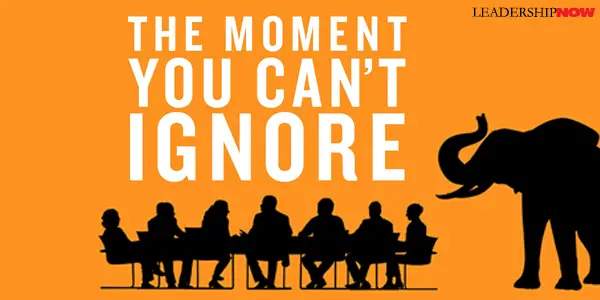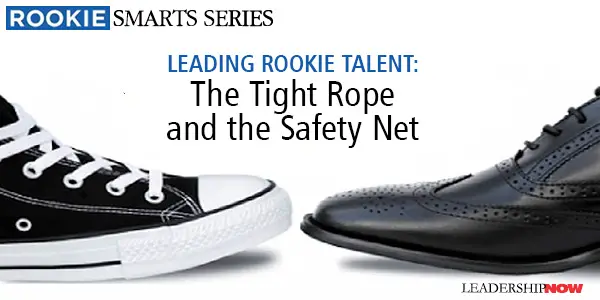 Leading Blog | Posts by Month |
 Leading Blog | Posts by Month |
10.31.14

LeadershipNow 140: October 2014 Compilation
See more on
Posted by Michael McKinney at 01:56 PM
10.28.14

The Power of NoticingHarvard professor Max Bazerman believes in the power of noticing. Sometimes we get so focused on what is right in front of us that we miss the critical information that would help us to make better decisions.The Power of Noticing guides us through what happens when our focus can prevent us from seeing the critical information we need to make better decisions. Focusing too narrowly on the information in front of us is common too us all. Where we would never do it in certain situations we can easily do it in others. Loyalty creates “blinders to full awareness and action.” Personality cults end badly for this very reason. “When we have a vested self-interest in a situation, we have difficulty approaching that situation without bias, no matter how well-calibrated we believe our moral compass to be. We want to think the best of our kids and spouses, and we’re disinclined to speak against those with influence in our offices and our occupations.” And so we don’t speak up when we should or we miss the kind of information we need to make the best decision. “Through our silence and complacency we accept and promote corruption.” When we don’t take the time to notice growing issues or simply chose to ignore them, corrupt systems develop around us. Sometimes we don’t get the information we need or fail to see the obvious because of misdirection. Thinking logically helps us to avoid this kind of decision-making trap. “When you start to stray from logic, and another person is involved, whether she is a negotiator, marketer, or politician, it is time to put yourself in the shoes of the other party, understand her motives, and adapt accordingly.” We are also unlikely to notice gradual changes. It is easy to miss or more likely to accept changes in ethical behavior until it’s too late because of this slippery slope effect. “Too often executives have engaged in unacceptable behavior not because they intend to defraud but simply to justify the mess that they got into.” There are more obvious things we don’t notice or rather do notice but our human nature gets the best of us. Things that are “too good to be true” require investigation. Bazerman explains why penny auctions are nothing but gambling. The house always wins. “Thinking one step ahead allows you to identify when to be trusting and when to be cynical.” It is wise to think through the indirect effects of your organizational policies and goals. What is the possible downside? What might it cause people to do unintentionally? “Focusing is important, but sometimes noticing is better—at least when you are making critical decisions.” Of Related Interest: 
Posted by Michael McKinney at 06:53 PM
10.23.14

The Moment You Can’t Ignore
A LEADER once told me, “We’re stuck.” It was an un-ignorable moment that reflected a cultural issue within the organization. In this case, it hinged around a destructive, persistent, self-perpetuating organizational belief about what leadership should look like that had plagued it for decades. Un-ignorable moments, write authors Malachi O’Connor and Barry Dornfeld, “typically occur when an organization is teetering on the brink of a cultural shift.” They share four characteristics: they are public in nature, they are irreversible, they are systemic, and they challenge the identity of the organization.What makes an un-ignorable moment so powerful is that the clash of cultural expectations doesn’t stop with the individuals engaged in the incident. Because identity is formed in part through group memberships, the moment calls into question the identity of the entire group—not just the identities of the people directly involved. It often shakes up the groups involved in ways that call into question why they work the way they do, and this can be very disturbing. Being stuck is not an entirely bad thing if you can use it to propel you forward. But of course it takes a secure and selfless leader. The challenge is “not to tamp the energy down but to draw it out and channel it.” It helps if you think of it this way: “The tensions and bottlenecks inside your organization can act as a source of creative energy. This is often not the case with places in the organization where everything is running smoothly, everyone feels comfortable, and there are no tensions or pressures. Those places rarely stir up change.” And therefore they don’t grow. When you feel unsettled it is a good sign that something new and interesting may be happening. Listening becomes a key quality. If you lack it as a leader you will miss it and the price you pay may be your own irrelevance. The authors encourage us to look within the organization itself for answers. “Where does the solution already exist? Where is the future already happening in your organization right now?” To successfully lead through a cultural shift, leaders need to command and collaborate. But not a command style that displays a “dictatorial disregard for the capabilities of others,” but “by creating a commanding presence and a commitment to developing the capabilities of others throughout the organization.” They recommend you focus on two central tasks: “protect the organization by keeping it within its safety zone during times of cultural transition, and guide and direct the organization as a conductor artfully leads an orchestra.” The Moment You Can’t Ignore helps us to look at those things we often don’t want to address if organizational success is our primary focus. O’Connor and Dornfield note that “Culture is not the solution to every challenge, but it is the source material from which solutions can be drawn.” 
Posted by Michael McKinney at 10:45 PM
10.20.14

Leading Rookie Talent: The Tight Rope and the Safety Net
IS IT possible that we are actually at our best when we are least qualified for the job? In my research studying the situations and types of leaders that bring out the best in people, I’ve noticed a counterintuitive but persistent theme: people tend to do their best work when they are out of their comfort zone, doing something important and difficult – often for the very first time. When we are stretched to our limits (and often beyond), we are forced to focus, and we learn fast – a mode I call “rookie smarts.” Working high above ones skill level can feel like a tight rope act – these new performers feel the tension and know that all eyes are on them. It is inevitable that they will wobble and perhaps even fall off at some point. The best leaders and mentors must not only place someone up on the tightrope; they must also be there to catch them when they fall. BTS, a global consulting firm, developed a highly effective system for launching and securing rookie talent on high-stakes projects. Vice president and partner Dan Parisi said, “Our job is to move people from left to right, up a learning curve. When there’s a steep learning curve, you need to build a safety net under it.” On every project, one person, such as the account manager, is the designated safety net. When veteran consultants or project managers assume this role, it is their job to launch the junior talent and be their safety net. When they see a struggling team member, they intervene without usurping control and then put the rookie back on the tightrope. How can managers intervene without usurping control and avoid the resentment that can come from public recognition of the protégé’s false steps? No one likes falling off the tightrope, landing on her back, and needing to be “saved” by the boss. Here’s how BTS uses safety nets to launch people, not deflate them:
A stretch assignment – working high on a tight rope – can be terrifying, both to walk and to watch. But with the dual promise of top performance and professional growth, smart leaders see constructing these challenging assignments as one of their most critical roles. They’ve learned to get comfortable asking others to be uncomfortable. Leaving our comfortable perch is never easy. Many of us go kicking and screaming. Those who venture out can feel the exhilaration of top performance. They might also feel their manager’s reassuring pat on their shoulder, followed by a gentle push.  
 
Posted by Michael McKinney at 01:12 AM
10.16.14

Leading Rookie Talent: Helping New Recruits Hit the Target
ARE your new employees loose canons or heat-seeking missiles? Rookies – people of any age who are new to a task – aren’t weighed down with old assumptions and are more likely to explore new possibilities. Lacking knowledge of their own, they seek out and mobilize a network of experts – my research found they consult with five times more experts than experienced people do. Because they are unsure of themselves they take small, calculated steps and move fast, so they can get feedback. Their lean and agile way of working is extraordinarily valuable in dynamic environments where yesterday’s best practices don’t apply. So, if rookies are really so valuable, should managers turn them loose and let them go? Rookies work fast, but sometimes they run in the wrong direction and get to the wrong answer quickly. Too often a wide-open terrain can leave them wandering aimlessly. A commanding officer in the U.S. Navy said, “Rookies are all thrust and no vector.” They’re full of energy and willing to do the work, but they need to be pointed in the right direction. To provide clear direction, start by doing what you would do for your more experienced staffers—clarify what needs to be accomplished and why it’s important. But, take it further, providing a clear target and the rules of engagement.
While rookies need clear direction, they also need space to explore, experiment and even make mistakes. So once you’ve helped them lock onto a target, make sure they have a practice field to build their skills. You can create a space for experimentation by defining two categories of work: 1) those tasks where success has to be ensured and 2) those where failure can be recovered from. This second realm becomes your safety range—a safe space for you, your team or newcomers to struggle and potentially fail without harming your stakeholders or their business. Within this space, identify a project where you or your colleagues can take a risk, and then in a series of small, calculated steps, iterate until the solution hits the mark. You might even offer the assurance, “In this space, if you totally blow it, I’ve got you covered.” Not only are your rookies capable of doing amazing work themselves, they may just be the spark that unleashes a wave of rookie thinking across your entire team – even with your most experienced staff. But for them to make their mark, they need leaders who know when to rein them in and when to unleash them. So when you release these emerging titans, make sure they are charging for the right target. Watch for my next guest post where we’ll explore how to provide your rookie talent both a tight rope to perform on and a safety net in case they stumble.  
 
Posted by Michael McKinney at 05:33 AM
10.13.14

Leading Rookie Talent: A Sizing Guide for Stretch Assignments
ROOKIES: Bumbling newbies that require copious management? Or underutilized top performers that need to be turned loose? While we often think of newcomers (be they young employees or experienced staff from another arena) as empty vessels that need to be filled up, my research shows that being a rookie – facing a new problem or a challenge for the first time – can provoke top performance. In the realm of knowledge work, rookies tend to outperform those with experience, especially when it comes to innovation and speed. Why? Because they aren’t encumbered with previous knowledge and resources. And, they are hungry. Needing to close a knowledge gap quickly, hyper-learning kicks in, causing them to seek out guidance, experiment and get rapid feedback. They work lean and agile, the smart way all professionals should be working in the current, constantly changing environment. When cycles spin fast and knowledge doesn’t stand still, many leaders never face the same problem twice. In this environment, the ability to learn is far more critical than one’s accumulated knowledge. While rookies are more capable than we might think, they still need leadership and guidance. For starters, they need the right-sized challenge – one that is big enough to really stretch them, but not so big as to break them. When the learning gap is too big, people can easily become overwhelmed and simply let go (or break down). However, when the challenge is too small, people never engage. How do you create the right sized stretch challenge? When someone is in a rookie assignment, err on the side of making the first challenge doable—make it a constructive “micro-challenge,” one with enough tension to create movement and with just the right mix of relevance, difficulty and opportunity for recognition. For more junior staff, carve off a project that can be completed within two weeks, so the rookie gets immediate feedback and recognition. When Jen Lamorena, eBay’s manager of college recruiting, brought on her own new hire, Jen gave her an important project – create and execute a social media strategy to support the firm’s initiative to recruit top university talent. The newly hired employee appeared to go into a spin cycle and sent out a few distress signals. Jen didn’t step in and micromanage, she scoped out a micro-challenge – create a video. With this clear starting place, the new staffer began making connections and mobilizing resources and within two weeks had produced an astonishingly great video that built the confidence she needed to tackle the larger campaign. When establishing the degree of stretch, leaders must also consider what is at stake and reconcile the tension between letting people learn and protecting others from their potential mistakes. While I was teaching a leadership seminar at a hospital for Yale Medical School, several physician-leaders who oversee residency programs voiced an intriguing frustration. While they wanted to give the resident physicians space and freedom to do their best work, the life-and-death nature of their work forced them to micromanage and bark orders. They insisted that there was no room for learning when someone is flatlining on the operating table. I agreed and asked, “What percentage of your time is spent in these situations?” They suggested it was probably 3-5 percent of their time. Yes, these critical situations aren’t rookie moments. But the other 95-97 percent of the time just might be. Along with a micro-challenge, rookies need micro-feedback—a steady stream of information to help them course-correct and stay on track. The best feedback comes in small doses and quick bursts, typically delivered in drive-by fashion rather than formal meetings. The newer someone is to a task, the more feedback they need and the more they need you to recognize and reflect what they are doing right.
When leaders offer a right-sized challenge, they spawn a success cycle. As the newcomer contributes quickly, they build confidence and are ready for an even bigger challenge. With the right leadership, they’ll become perpetual rookies, living and working permanently on the steep side of a learning curve. Watch for my next guest post where we’ll explore how to provide your rookie talent the right combination of freedom and direction.  
 
Posted by Michael McKinney at 11:32 PM
10.01.14

First Look: Leadership Books for October 2014Here's a look at some of the best leadership books to be released in October.




For bulk orders call 1-800-423-8273  Build your leadership library with these specials on over 100 titles. All titles are at least 40% off the list price and are available only in limited quantities. “No two persons ever read the same book.” — Edmund Wilson
Posted by Michael McKinney at 03:25 PM
|
BUILD YOUR KNOWLEDGE


How to Do Your Start-Up Right STRAIGHT TALK FOR START-UPS 
Grow Your Leadership Skills NEW AND UPCOMING LEADERSHIP BOOKS 
Leadership Minute BITE-SIZE CONCEPTS YOU CAN CHEW ON 
Classic Leadership Books BOOKS TO READ BEFORE YOU LEAD |
|